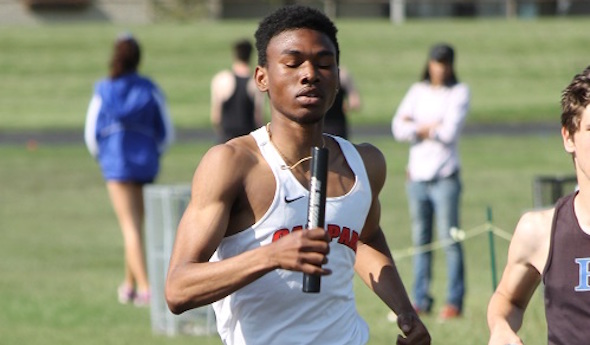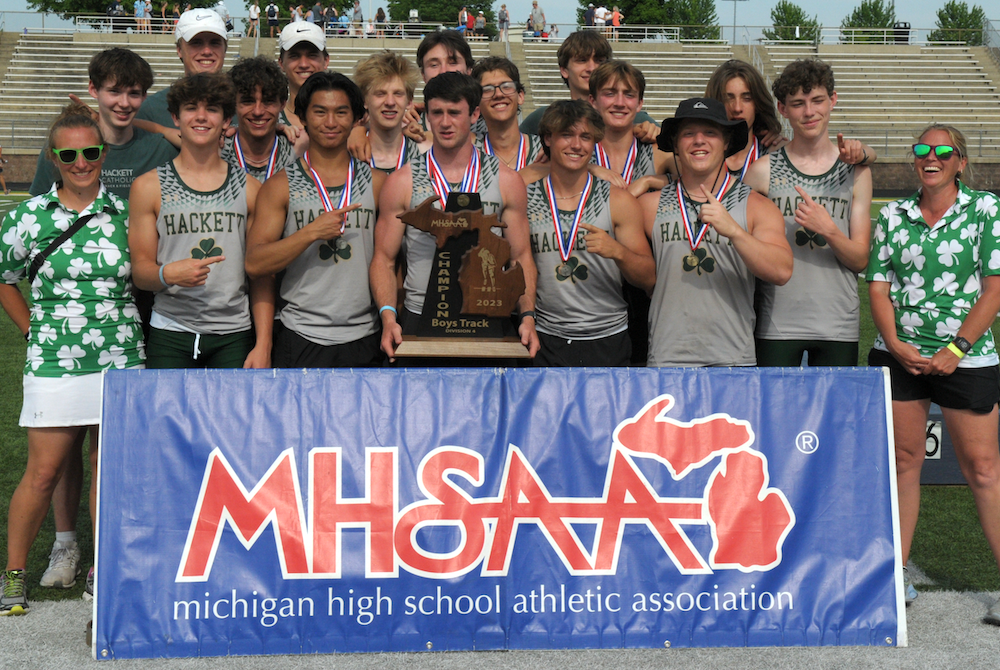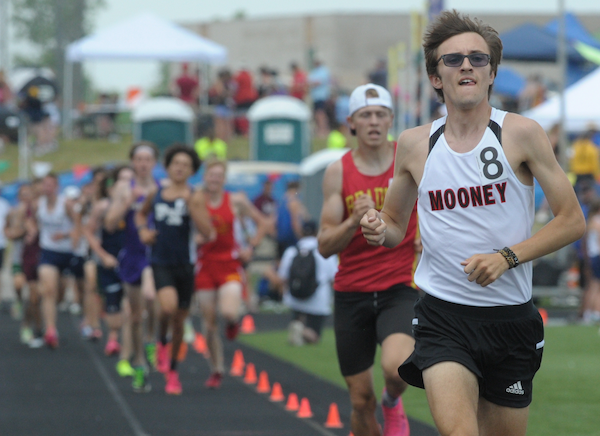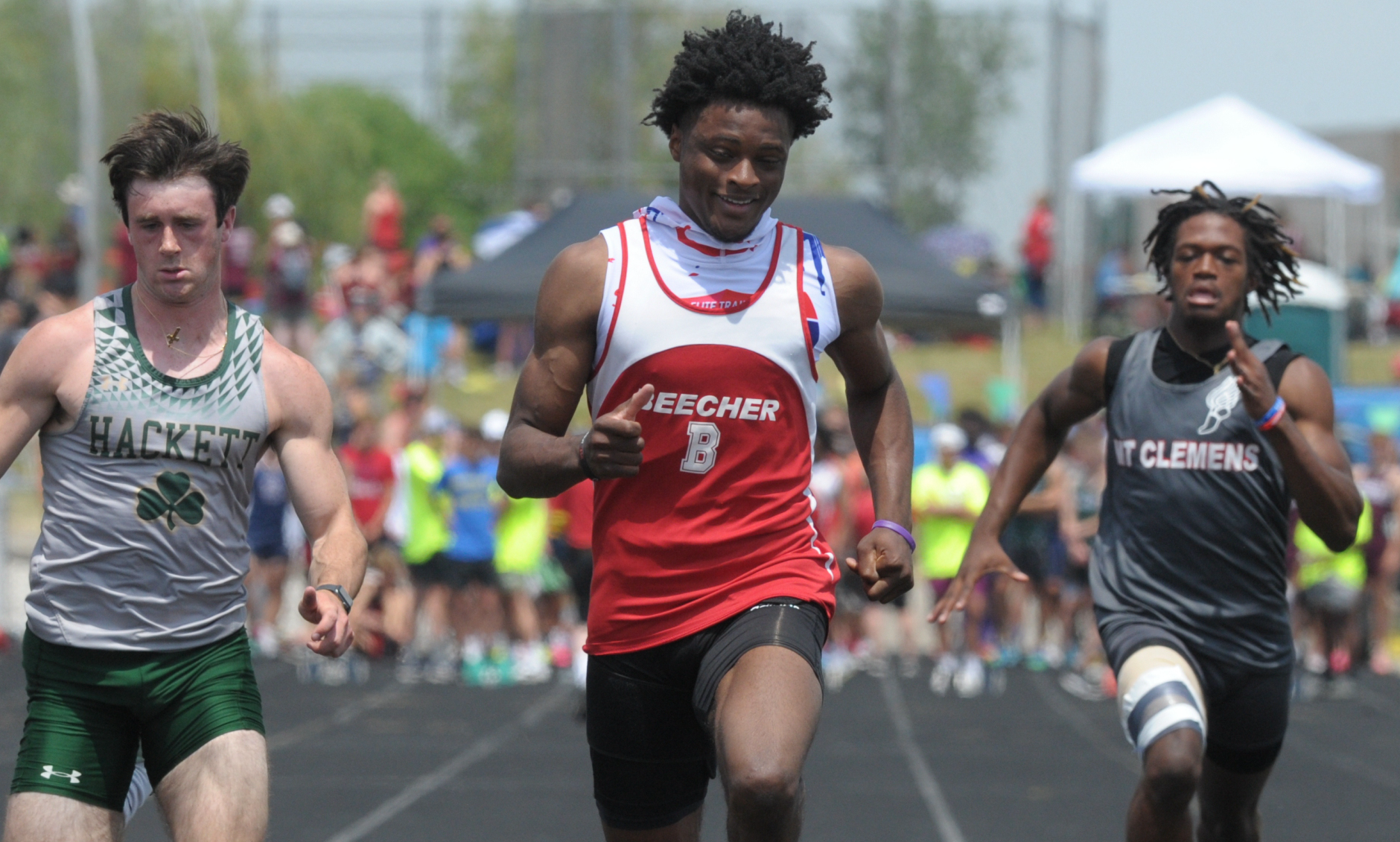
Cooper Closing In On Fantastic Finish
By
Tom Markowski
Special for Second Half
May 2, 2017
OAK PARK – As good as he is as a runner, Cameron Cooper understands he can’t do it alone.
Running one last high school season guided by knowledgeable veteran coaches and with a friend to help set their team's pace, the Oak Park senior is sprinting toward a captivating conclusion to his high school career and with more exciting possibilities ahead.
 Cooper, 18, helped the Knights win the 2016 MHSAA Division 1 title, the program’s first boys track and field championship since 1972, as he placed first in the 800-meter run with a time of 1:51.68.
Cooper, 18, helped the Knights win the 2016 MHSAA Division 1 title, the program’s first boys track and field championship since 1972, as he placed first in the 800-meter run with a time of 1:51.68.
He then became just the second runner to go under 1:49.5 indoor when, while running with the Motor City Track Club, he placed first at the New Balance Nationals (March 10-12) held in New York City. His time of 1:49.46 eclipsed his personal-best of 1:49.7. Robbie Andrew of New Jersey owns the indoor record of 1:49.21 run in 2009.
Minutes after running the second-fastest time in the half mile, Cooper said he thought he could run faster – and he believes a time of 1:46 is attainable now that he’s competing outdoors.
“Outdoors, you can run faster,” Cooper said, noting there are only two turns on outdoor tracks instead of four at smaller indoor venues.
Although his times don’t reflect this outdoor advantage yet, Cooper is finding his fastest stride as the season’s most important meets draw near. Cooper has won all of his races this spring – individually or as part of a relay – and his top 800 time of 1:51.79 is only a tenth of a second slower than last season’s MHSAA championship performance.
Mentoring and hard work
Cooper began running competitively at the age of 8 with the Detroit PAL (Police Athletic League). He ran the sprints before his coach, Reggie Osborne, moved him to the 400 and 800 runs at age 10.
“When I was younger, it was way easier,” Cooper said. “In high school now, it’s more competitive. There (are) better runners.”
Cooper said there’s no secret to his success. Sure he’s a gifted runner, but it’s the hours of training that enable him to compete at such a high level.
His coaches at Oak Park – longtime Detroit Public School League coach Bob Lynch, now in his third season at Oak Park, and his protégé, Brandon Jiles – both work with Cooper almost daily. Officially, Lynch is the boys track coach and Jiles coaches the girls team, but in essence they team to coach both squads.
Jiles won the Class A Finals 800 in 1999 at Detroit Mumford with Lynch as his coach. Mumford won the Class A team title that season. The Mustangs would win three more MHSAA Finals titles (Division 1, 2002-04) with Lynch.
Then there’s Chris Richards, a Detroit Pershing graduate, who works with the sprinters on both teams. Although Richards doesn’t work directly with Cooper, his presence allows Lynch to spend more time with a runner like Cooper.
“Lynch’s specialty is the sprints,” Richards said. “I don’t know where, all of a sudden, he became an expert on the half mile and mile.”
That was said partly in jest. Lynch is highly regarded in the sport and has worked well with all athletes in running events whether they’ve been hurdlers, sprinters or distance runners.
Lynch has coached many greats, Olympian Marshall Dill for one, and he said Cooper is one of the best he’s had.
“It’s the work he puts in,” Lynch said. “Whatever I make him do, he does it. But I have to push him. His older brother (Corey Jones) influenced him. (Jones) was decent as an age-group runner, but he wasn’t a great runner. He worked hard to be where he was at.”
Jones ran for Lynch when he was the head coach at Detroit Mumford. Five years older than Cooper, Jones continues to have a positive influence on his brother.
 “He wasn’t that talented,” Cooper said of his brother. “He’d run a lot on his own. Just seeing his work ethic made me want to run. He still works harder than I do. I do a lot of stuff on my own, too, like pushups and stuff. Corey had to work harder just to get his times. I have more talent, so I don’t work as hard.”
“He wasn’t that talented,” Cooper said of his brother. “He’d run a lot on his own. Just seeing his work ethic made me want to run. He still works harder than I do. I do a lot of stuff on my own, too, like pushups and stuff. Corey had to work harder just to get his times. I have more talent, so I don’t work as hard.”
Even so, Cooper, who also placed fourth in the 1,600 at the Division 1 Final a year ago, understands he needs to work harder to reach his goals.
It’s not easy. When you add that he’s also one of the state’s top milers, Cooper’s work regiment can be overwhelming. To train for the 800 he’ll run 400 meters, then 600 meters, then 200. Then he’ll repeat that sequence. When training for the 1,600, he’ll run 1,200 meters, 1,000 meters and, again, repeat that. By week’s end he’ll run 15 miles or more, not counting what he does in meets.
Last weekend at the Jackson Invitational, Cooper ran the 800 in that season-best 1:51.79, one of the top times in the state. He also ran the 1,600 in 4:18, also one of the state’s top times this spring. Cooper is also the anchor on the 1,600 and 3,200 relay teams, and both ran well in Jackson according to Jiles.
Running mate
Dewan Hawthorne is another senior on a veteran team. Hawthorne is a hurdler and also runs the first leg on the 3,200 relay. Hawthorne qualified for the Division 1 Finals in both hurdle events and placed ninth in the 300 low hurdles last season. Cooper and Hawthorne, along with sprinter KeVeon Clark, are the three athletes Lynch is counting on to set the standard for the other runners – and to score points.
Cooper and Hawthorne feed off of one another and are often seen running laps together in practice.
“Our team is stronger this year,” Hawthorne said. “We have some new guys, but me and Cameron are the big two. We both run cross country, and that helps us going into the indoor season. When the outdoor (season) comes, we’re ready.”
This season’s important meets are coming on quickly. Oak Park will host the Oakland Activities Association league meet on May 11, and the Knights will compete at the North Farmington Regional on May 19. Qualifiers will compete at the Division 1 Finals at East Kentwood on June 3.
After that, Cooper and Hawthorne plan on competing in college, and neither has made a firm commitment to a university. Cooper has narrowed his choices to Clemson, Florida, Louisiana State, Oregon and Texas A&M. Hawthorne is deciding between Michigan State and Morgan State.
 Tom Markowski is a columnist and directs website coverage for the State Champs! Sports Network. He previously covered primarily high school sports for the The Detroit News from 1984-2014, focusing on the Detroit area and contributing to statewide coverage of football and basketball. Contact him at [email protected] with story ideas for Oakland, Macomb and Wayne counties.
Tom Markowski is a columnist and directs website coverage for the State Champs! Sports Network. He previously covered primarily high school sports for the The Detroit News from 1984-2014, focusing on the Detroit area and contributing to statewide coverage of football and basketball. Contact him at [email protected] with story ideas for Oakland, Macomb and Wayne counties.
PHOTOS: (Top) Oak Park's Cameron Cooper runs his leg of the 3,200 relay during a tri-meet against Royal Oak and Ferndale this season. (Middle) Dewan Hawthorne (left) and Cooper. (Top photo courtesy of Darrell Washington.)

Thrower Claims Lone Individual Title to Lead Hackett to Team 3-Peat
By
Tom Lang
Special for MHSAA.com
June 3, 2023
Kalamazoo Hackett Catholic Prep just keeps winning and winning.
This time the Irish took home their fourth title in the last five Lower Peninsula Division 4 Track & Field Finals, on Saturday at Hudsonville.
Hackett’s only individual title was taken by discus winner Nathan Buchmann, a senior, who was fine knowing he was the shortest in stature among all the sizable competitors.
“In the offseason after football I worked out every day, working towards this goal,” he said after getting his medal. “I would say this takes 80 percent technique and 20 percent strength to throw the discus. So, length can help but if you have good technique and are really strong, that will play into it.
“I think we are very balanced throughout the meet today,” he said about teammates that scored points in finishes other than first place. “We have 13 guys here today, and we have people in a lot of the races. But I do not run; I have too short of legs to be a fast runner,” he said with a chuckle.
Buchmann had to work through a hip injury to compete this spring.
“I think the setbacks are what make you strong,” he said. “You can either give up through the setbacks or push forward and become better.”
 Coach Charissa Dean agreed.
Coach Charissa Dean agreed.
“The kids have big hearts,” she said after all the points were totaled and the Irish were on top once again, with 53. “They worked hard. They had a lot of potential when we started the season. And we had a lot of drive to put in the work, and we are happy the results came out the way they did.”
Reading was runner-up at 47 points, followed by Wyoming Potter’s House Christian with 42, then Fowler and Flint Beecher each with 37 points.
Senior Lezawe “Moses” Osterink, of Potter’s House Christian, placed second in 1,600 but took the 3,200 title as defending champ of both. He dominated the latter by lapping the field with a final lap kick that resembled more of a superhero speedster.
“Nobody really took it out that hard at the start,” he said. “There was a freshman (Marek Butkiewicz of Hackett) that tried to get the pace going quick, but me and Dakota (Dykhuis of Montabella) just kind of sat back and gradually pulled him through.
“We took it gradually, and I was just relying that I could kick.”
Kick did he ever. The trio were neck and neck the majority of the race in a grouping ahead of the pack.
“With 400 to go I just tried to go all out,” Osterink said. “I had a lot more left than I thought and I was pleased with the win. Not really the time, but that doesn’t matter, especially this hot out.”
The overall meet was in the low 90s/high 80s heat and searing sun all day. So, race officials allowed the unique opportunity for coaches to spray the runners with water and give them water bottles.
“It was very weird because I’ve never taken water to drink while I’m running, so I didn’t know how that would feel,” Osterink said. “And they were spraying us and hitting us in the face. It was kind of fun.”
Junior Tyler Lenn of Marine City Cardinal Mooney defeated Osterink at his own game in the 1,600.
“I’m feeling great,” Lenn said after grabbing the medal. “I said to a newspaper after one of my races (during the season) I was right where I wanted to be. This has been a long rebuilding process for me since an injury back in the fall, and I set a pretty high goal the day the injury happened. I was telling myself I needed to fulfill what I said I would do at the beginning of last cross country season. And that is what I did today.”
Lenn suffered an ankle sprain from a misstep that turned worse because he kept running through the season on it.
“Coming back from that was pretty tough, but I wouldn’t have it any other way,” he said.  “Perseverance; I said from the beginning what I was going to do. I kept my eye on that target, and no matter the circumstances life threw at me, that I was going to make it happen and I am a man of my word.”
“Perseverance; I said from the beginning what I was going to do. I kept my eye on that target, and no matter the circumstances life threw at me, that I was going to make it happen and I am a man of my word.”
Jaylin Townsend, a senior from Flint Beecher, dominated the short races. He won the 100 dash (10.67) and 200 dash at 22 seconds flat. It was his third 100 win at a Finals.
“I put in a lot of work; I had to three-peat,” he said after the 100. “There’s a lot of great competition here, so I knew I had to come out and run my best.”
Concord in the 400 (43.72), Buckley in the 800 (1:30.76) and 1,600 (3:29.13) and Potter’s House in the 3,200 (8:14.18) were relay champs Saturday. Reading’s Tayshawn Bester won the 110 hurdles (15.13), and Athens’ Landen Bennett won the 300 (39.85). Caseville’s Nathan Feltner won the 400 (50.76), and Vestaburg’s Owen Patton claimed the 800 (1:55.11).
Fruitport Calvary Christian’s Bradley Richards won the high jump (6-10), and Peck’s Alex Affer won the long jump (23-4). McBain Northern Michigan Christian’s Isaac Bowden was first in pole vault (13-0), and Brown City’s Kyle Affer won shot put (49-2).
PHOTOS (Top) Kalamazoo Hackett Catholic Prep celebrates its third-straight LPD4 title Saturday. (Middle) Cardinal Mooney's Tyler Lenn, far right, sets the pace in the 1,600. (Below) Flint Beecher's Jaylin Townsend, middle, crosses the finish first for one of his two sprint championships. (Photos by Ken Swart/RunMichigan.com.)

